Thailand Fertilizers Market Size
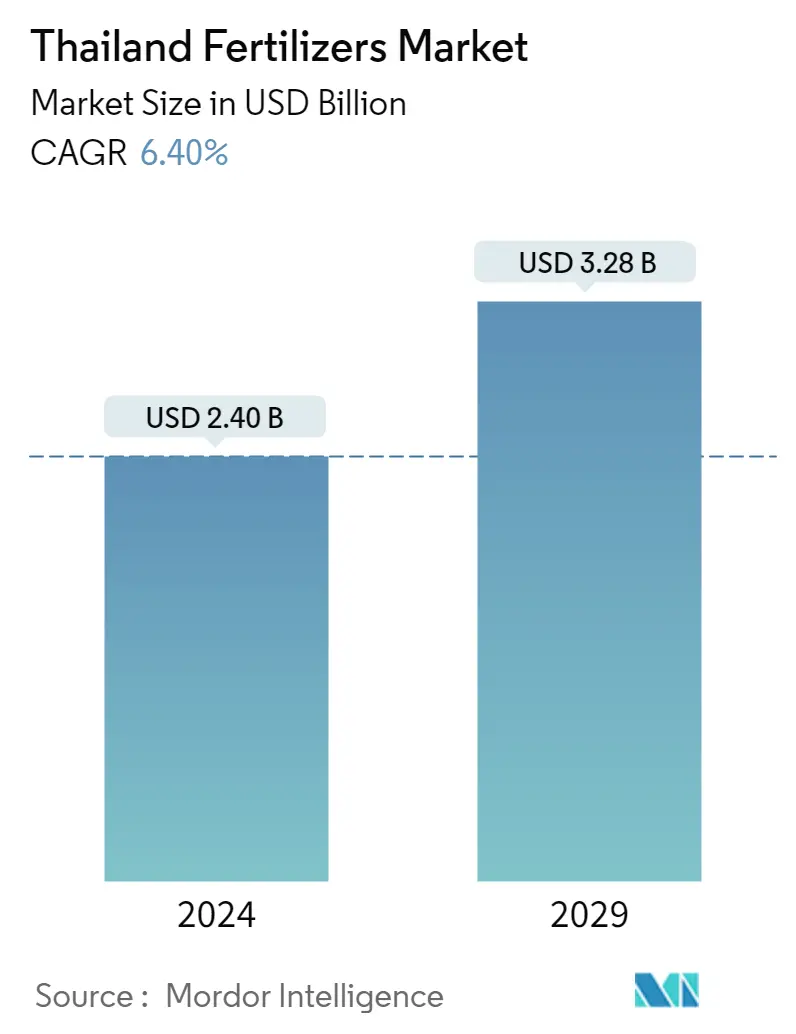
| Study Period | 2019 - 2029 |
| Base Year For Estimation | 2023 |
| Market Size (2024) | USD 2.40 Billion |
| Market Size (2029) | USD 3.28 Billion |
| CAGR (2024 - 2029) | 6.40 % |
| Market Concentration | Medium |
Major Players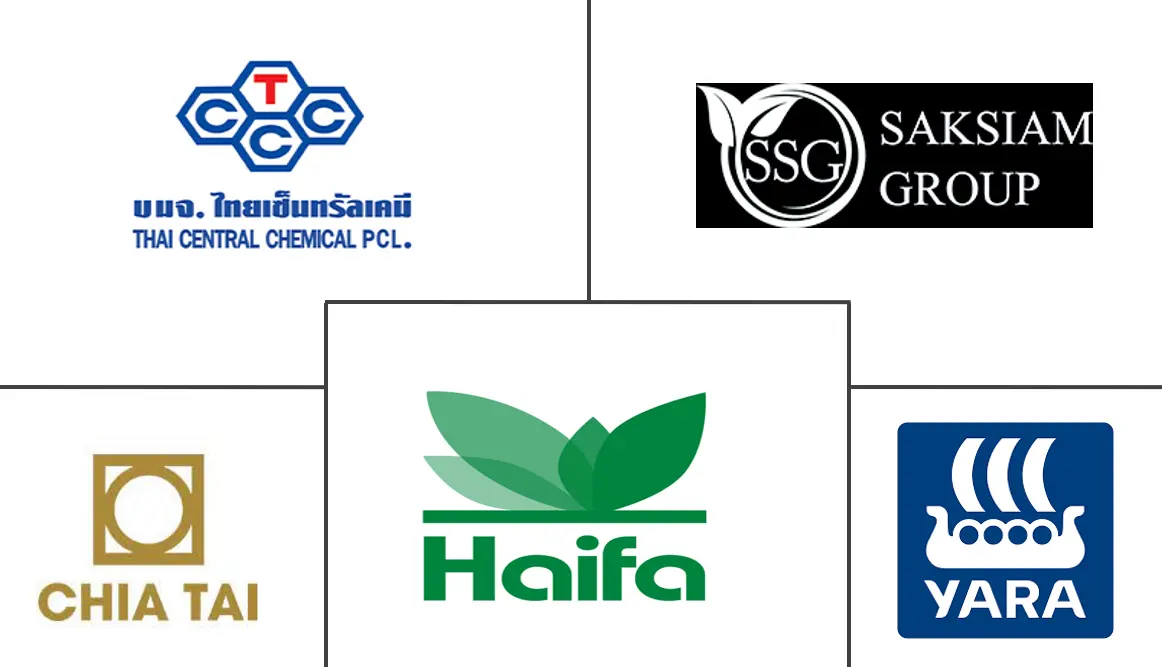
*Disclaimer: Major Players sorted in no particular order |
Need a report that reflects how COVID-19 has impacted this market and its growth?
Thailand Fertilizers Market Analysis
The Thailand Fertilizers Market size is estimated at USD 2.40 billion in 2024, and is expected to reach USD 3.28 billion by 2029, growing at a CAGR of 6.40% during the forecast period (2024-2029).
COVID-19 has a direct and negative impact on the value chain of the fertilizer market. The lockdown in Thailand has affected the transportation systems adversely. The primary raw materials used in the production of chemical fertilizers include ammonium, sulfuric acid, phosphorous, and potassium. The logistics restraints limited the supply of the raw material, and also, the prices of the fertilizers impacted the domestic fertilizer industry during the pandemic. Spike in fertilizer prices was also observed in 2020, owing to the logistics ban and increased international prices of phosphates and urea.
The increasing adoption rate of new technologies by farmers, increasing agricultural productivity, and growing country population are some of the major factors driving the Thailand fertilizer market. Additionally, the government has supported the farmers by providing them indirect intervention through fertilizer subsidy, i.e., cheap fertilizers and soft loans. For instance, in 2019, the government announced to launch new stimulus measures for the Thai farmers in the form of cheap fertilizers. This measure will be included on the state welfare smartcard, to provide subsidy directly to the card holders. It also announced a budget of TBH 60.36 billion (USD 1.98 billion) for three agricultural price subsidy programs for small rice and oil palm farmers in 2019. The rise in support provided to the farmers has led to the increased consumption of fertilizers, in order to increase the farm productivity. Similar trend is expected to be seen in the coming years.
Nitrogenous fertilizer dominates the market as the demand for notrogenous fertilizer is high owing to soil nitrogen deficient, due to the dominance of rice crops. Thus, nitrogenous fertilizers are the most frequently used, especially urea. For instance, according to IFASTAT, the nitrogenous fertilizer consumption in the form of Urea was 705.2 thousand metric ton in 2017. Despite the increasing area under organic cultivation in the country, the challenges in the usage of biofertilizers and organic fertilizers resulted in farmers to prefer synthetic or chemical fertilizers.
Thailand Fertilizers Market Trends
This section covers the major market trends shaping the Thailand Fertilizers Market according to our research experts:
Need for Increasing Agricultural Productivity
Despite the unchanged agricultural land in the country, agricultural productivity in Thailand is showing positive increment over the year. According to FAOSTAT, the cereal production in the country was 38,175,650.0 metric ton in 2017, which has reached 35,507,800.0 thousand metric ton in 2020. This decrease in agricultural production in the country is will lead to increased adoption of various agricultural products and technologies, including fertilizers.
The arable land in Thailand holds nearly 32.9% of the total land area in 2018, according to the world bank data. The largest number of farm holdings are located in the Northeastern region. In the region, along with the insufficient supply of land, some other factors, such as poor-quality soil, seasonality, variability of rainfall, scarcity of surface water, etc. Therefore, fertilizer application has become crucial to achieving higher productivity gains.
In order to boost the agriculture production in the country, the Thailand Government has supported the farmers by providing subsidies on-farm inputs. For instance, in 2019, the government announced to launch of new stimulus measures for Thai farmers in the form of cheap fertilizers. This measure will be included on the state welfare smartcard, to provide the subsidy directly to the holders. With the increasing agriculture production coupled with various government schemes, the demand for fertilizers in the country is expected to grow during the study period.
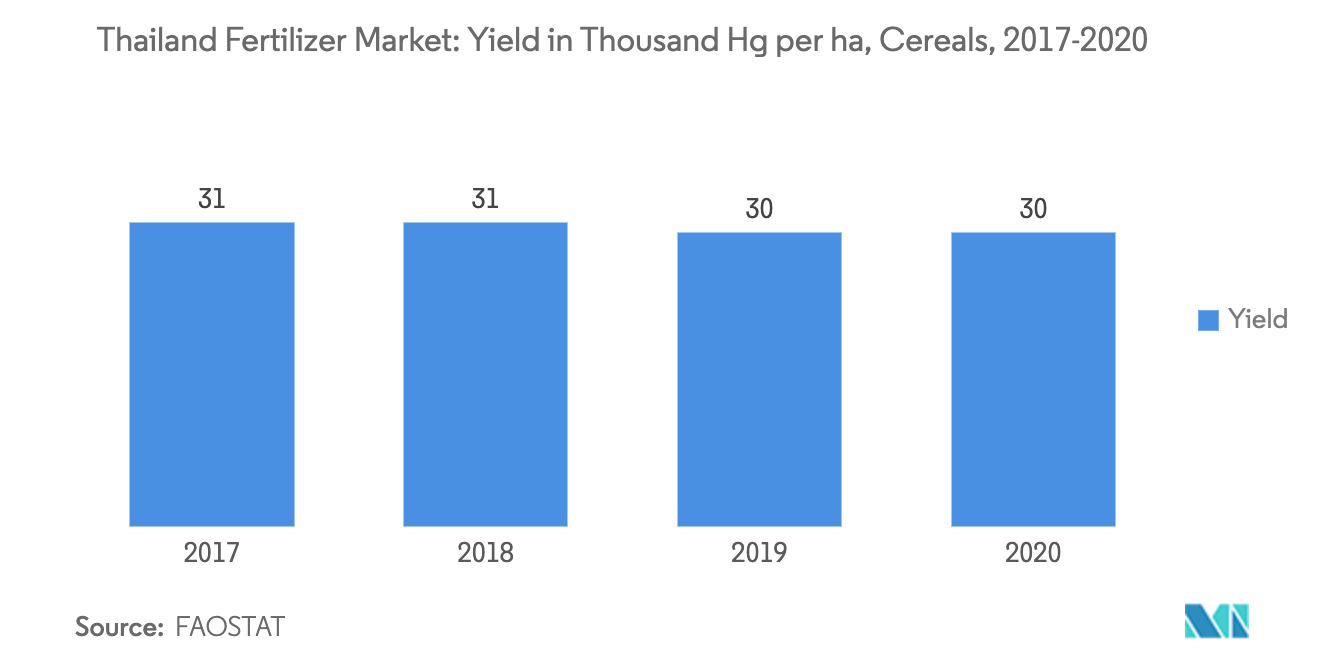
Nitrogenous Fertilizer Dominates the Market
Fertilizer use in Thailand is an integral part of agriculture, due to the declining availability of arable land and the increasing role of agricultural commodity exports in the economy. However, Thailand has a limited supply of raw materials for fertilizer, and therefore, the imports of both raw materials and pre-compounded grades for domestic production and distribution are high.
Most of the soil in Thailand is nitrogen deficient, due to the dominance of rice crops. Thus, nitrogenous fertilizers are the most frequently used, especially urea. Ammonium sulfate (AS) provides critical plant nitrogen (N) and sulfur (S) nutrients, compared to other N fertilizers, as ammonium sulfate has agronomic and environmental benefits against toxicity (aqueous NH3), N loss via NH3 volatilization, etc. Ammonium sulfate is another widely used nitrogenous fertilizer, only after urea, in Thailand.
Some of the major crops for which nitrogen is used include corn, cassava, and sugarcane which are all the key crops grown in the country. Urea is among the most imported fertilizers in Thailand, as it is the most widely used fertilizer. Chia Tai has a greater presence in the single-nutrient fertilizer urea market, because it has access to high quality urea from Russia. According to the Food and Agriculture Organization (FAO), value of urea imported in Thailand, in 2017, stood at USD 643,472.0 thousand, which has consistently increased to reach USD 903,877.0 thousand by 2021. Thus, the demand for nitrogen fertilizers in the country is anticipated to grow over the forecast period.
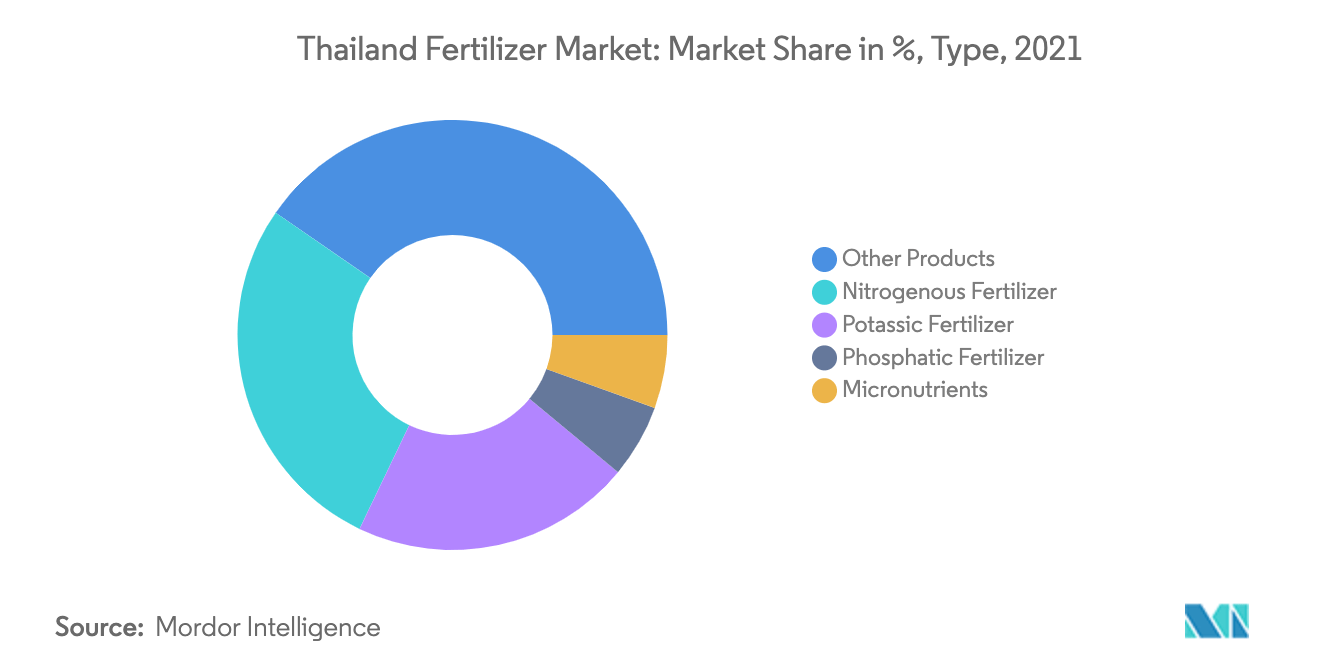
Thailand Fertilizers Industry Overview
Thailand Fertilizer market is moderately consolidated, with players such as Yara (Thailand) Company Limited, Haifa, Chai Thai Co. Ltd, Thai Central Chemical Public Company Limited, and Saksiam Group. being some of the active players in the market. Mergers and acquisitions, partnerships, expansion, and product launches are some of the most adopted business strategies by these active players.
For instance, in 2020, Yara Thailand Company Limited, in collaboration with DTAC, a telecommunication service provider, launched an app called 'Kaset Go,' which educates the farmers in using modern technologies to increase the crop yield. This innovation may boost the sale of the Yara fertilizers as the farmers begin to gain more knowledge.
Thailand Fertilizers Market Leaders
Yara (Thailand) Company Limited
Thai Central Chemical Public Company Limited
SAKSIAM GROUP
Chai Tai Group
Haifa Group
*Disclaimer: Major Players sorted in no particular order
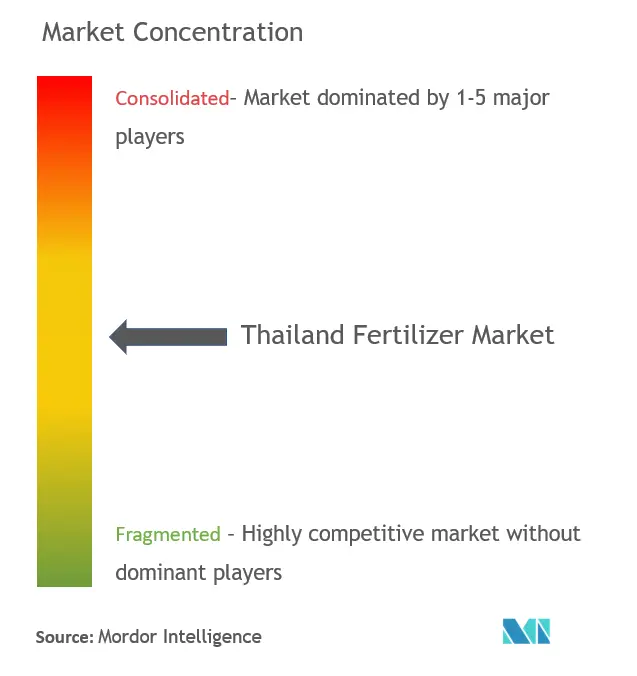
Thailand Fertilizers Market News
Players in the Thailand fertilizer market are adopting various business strategies, including mergers and acquisitions, product launches, expansions, partnerships, etc.
For instance, in 2020, Yara Thailand Company Limited, in collaboration with DTAC, a telecommunication service provider, launched an app called 'Kaset Go,' which educates the farmers in using modern technologies to increase the crop yield. This innovation may boost the sale of the Yara fertilizers as the farmers begin to gain more knowledge.
In 2020, Yara Thailand Company Limited has also launched a new granular fertilizer product for water systems in Thailand. The product was launched as a premium product targeting the greenhouse, farms using fertigation systems, etc.,
Thailand Fertilizers Market Report - Table of Contents
1. INTRODUCTION
1.1 Study Assumptions and Market Definition
1.2 Scope of the Study
2. RESEARCH METHODOLOGY
3. EXECUTIVE SUMMARY
4. MARKET DYNAMICS
4.1 Market Overview
4.2 Market Drivers
4.3 Market Restraints
4.4 Porter's Five Forces Analysis
4.4.1 Bargaining Power of Buyers
4.4.2 Bargaining Power of Suppliers
4.4.3 Threat of New Entrants
4.4.4 Threat of Substitute Products
4.4.5 Intensity of Competitive Rivalry
5. MARKET SEGMENTATION
5.1 Product
5.1.1 Nitrogenous Fertilizers
5.1.1.1 Urea
5.1.1.2 Calcium Ammonium Nitrate (CAN)
5.1.1.3 Ammonium Nitrate
5.1.1.4 Ammonium Sulfate
5.1.1.5 Anhydrous Ammonia
5.1.1.6 Other Nitrogenous Fertilizers
5.1.2 Phosphatic Fertilizers
5.1.2.1 Mono-Ammonium Phosphate (MAP)
5.1.2.2 Di-Ammonium Phosphate (DAP)
5.1.2.3 Triple Superphosphate (TSP)
5.1.2.4 Other Phosphatic Fertilizers
5.1.3 Potash Fertilizers
5.1.4 Micronutrient Fertilizers
5.1.5 Other Products
5.2 Application
5.2.1 Grains and Cereals
5.2.2 Pulses and Oilseeds
5.2.3 Commerical Crops
5.2.4 Fruits and Vegetables
5.2.5 Other Applications
6. COMPETITIVE LANDSCAPE
6.1 Most Adopted Strategies
6.2 Market Share Analysis
6.3 Company Profiles
6.3.1 Yara (Thailand) Company Limited
6.3.2 NFC Public Company Limited
6.3.3 Chai Thai Co. Ltd
6.3.4 Thai Central Chemical Public Company Limited
6.3.5 Haifa Group
6.3.6 SAKSIAM GROUP
6.3.7 ICL Fertilizers(Ranthai Agro Co. Ltd)
6.3.8 Rayong Fertilizer Trading Company Limited (UBE Group)
6.3.9 COMPO Expert
6.3.10 ICP FERTILIZER COMPANY
7. MARKET OPPORTUNITIES AND FUTURE TRENDS
8. AN ASSESSMENT OF IMPACT OF COVID-19 ON THE MARKET
Thailand Fertilizers Industry Segmentation
According to OECD, chemical fertilizers are commercially produced, usually synthetic, chemical compounds, such as nitrogen, phosphorus, and potassium, as well as a variety of micronutrients and additives used in farming. . The Thailand fertilizers market is segmented by product (nitrogenous fertilizers, phosphatic fertilizers, potassic fertilizers, micronutrients fertilizers, and other products), and application (grains and cereals, pulses and oilseeds, commercial crops, fruits and vegetables, and other applications).
| Product | ||||||||
| ||||||||
| ||||||||
| Potash Fertilizers | ||||||||
| Micronutrient Fertilizers | ||||||||
| Other Products |
| Application | |
| Grains and Cereals | |
| Pulses and Oilseeds | |
| Commerical Crops | |
| Fruits and Vegetables | |
| Other Applications |
Thailand Fertilizers Market Research FAQs
How big is the Thailand Fertilizers Market?
The Thailand Fertilizers Market size is expected to reach USD 2.40 billion in 2024 and grow at a CAGR of 6.40% to reach USD 3.28 billion by 2029.
What is the current Thailand Fertilizers Market size?
In 2024, the Thailand Fertilizers Market size is expected to reach USD 2.40 billion.
Who are the key players in Thailand Fertilizers Market?
Yara (Thailand) Company Limited, Thai Central Chemical Public Company Limited, SAKSIAM GROUP, Chai Tai Group and Haifa Group are the major companies operating in the Thailand Fertilizers Market.
What years does this Thailand Fertilizers Market cover, and what was the market size in 2023?
In 2023, the Thailand Fertilizers Market size was estimated at USD 2.26 billion. The report covers the Thailand Fertilizers Market historical market size for years: 2019, 2020, 2021, 2022 and 2023. The report also forecasts the Thailand Fertilizers Market size for years: 2024, 2025, 2026, 2027, 2028 and 2029.
Thailand Fertilizers Industry Report
Statistics for the 2024 Thailand Fertilizers market share, size and revenue growth rate, created by Mordor Intelligence™ Industry Reports. Thailand Fertilizers analysis includes a market forecast outlook to 2029 and historical overview. Get a sample of this industry analysis as a free report PDF download.
